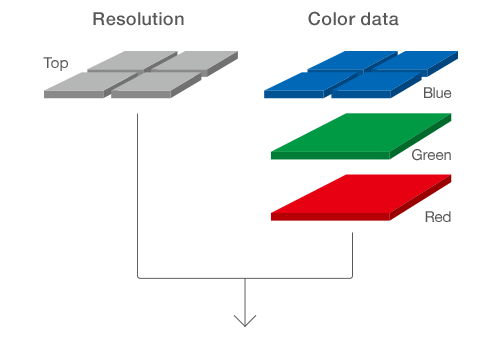An image processing system ready for higher resolution.
Outstanding performance, next-level image quality.
With its three-layer structure, the Foveon X3 Quattro direct image sensor captures all of the information carried by visible light. This film-like capture system offers rich gradations and color and truly distinctive image quality. Optimized to match the enhanced resolution and other characteristics of the image data, the image processing system of the new SIGMA sd Quattro leverages the outstanding fundamental functions of the camera while taking overall image quality to the next level.

Two sensor sizes available
The SIGMA sd Quattro incorporates an APS-C size sensor for outstanding medium format level image quality,
while the SIGMA sd Quattro H features a new APS-H size sensor for
51 megapixel-equivalent ultra-high image quality
Other cameras typically use a single-layer photo sensor covered by a Bayer filter mosaic, which comprises 50% green, 25% blue, and 25% red squares. In contrast, the Foveon X3 Quattro direct image sensor uses no low-pass filter and is able to capture 100% of the data for blue, green, and red in each of its three layers. Due to this unique structure, the Foveon X3 Quattro direct image sensor can generate up to twice the resolution data of sensors using a Bayer filter. The SIGMA sd Quattro has an APS-C-size sensor with 19.6 megapixels in its top layer, giving it an equivalent total of approximately 39 megapixels and the outstanding image quality expected of a medium format camera. The SIGMA sd Quattro H features a newly developed APS-H size sensor (26.7 x 17.9mm) with 25.5 megapixels in its top layer for an equivalent total of approximately 51 megapixels. This larger sensor takes Foveon image quality to the next level, delivering more detailed images than ever before.

Starting with our very first digital camera, we have featured the Foveon direct image sensor, which offers radically better image quality than any other sensor available. Leveraging the light absorption characteristics of silicon, the sensor comprises three layers of photodiodes, each at a different depth within the silicon and each corresponding to a different RGB color. Since it is the only sensor to use this superior vertical color separation technology, it is also the world’s only direct image sensor.
Almost all other image sensors are mosaic sensors, which use an array of RGB color filters in a single horizontal plane to capture color information. Each pixel is assigned only one of the three colors and cannot capture all three colors at once. In contrast, the Foveon direct image sensor captures color vertically, recording hue, value, and chroma accurately and completely for each pixel.
In the Foveon direct image sensor, there are no color filters which would cause a loss of information transmitted by light. Moreover, there is no low-pass filter needed to correct the interference caused by a color filter array. Finally, unlike the data from other sensors, which requires artificial interpolation to “fill in” missing colors, the data from the Foveon direct image sensor is complete for every single pixel and requires no interpolation. The unique technological principle of this sensor produces consistently outstanding image quality.
Foveon direct image sensor
The world’s only image capture system to use
vertical color separation technology

Capturing the information transmitted by light vertically instead of horizontally, the full-color image capture system of the Foveon direct image sensor is the only one of its kind in the world. This system makes possible the sensor’s full-bodied image quality, which is characterized by rich tone and gradation and texture that one can almost touch.
The newly developed Foveon X3 Quattro is the latest generation of this unique sensor. While retaining the distinctive characteristics of its predecessors, it offers an even higher level of image quality. Resolution is 30% higher, and its noise characteristics are further enhanced.
The new sensor structure features a ratio 1:1:4 for the number of red, green, and blue megapixels, respectively. The top layer captures luminance and color information, while the bottom two layers capture color information only. This unique structure prevents the deterioration of the signal-to-noise ratio that is typically associated with an ultrahigh megapixel count. At the same time, it makes possible high-speed data processing required for faithful color replication. Able to maintain the same exacting standard of image quality while increasing resolution and enhancing noise characteristics, this 1:1:4 solution was the inspiration for the name of the current generation of Foveon sensor: “Quattro.”
Newly developed Foveon X3 Quattro
direct image sensorNow featuring 39 megapixel-equivalent ultrahigh resolution
The new 1:1:4 structure (bottom 1: middle 1: top 4) offers higher resolution
that is equivalent to 39 megapixels for conventional color filter array sensors.
In addition to this ultra-high resolution, the sensor offers enhanced noise characteristics
and faster processing of high-volume image data.

The difference between the Foveon X3 Quattro direct image sensor and a conventional color filter array sensor (Bayer filter sensor)

The Foveon X3 Quattro leverages the selective absorption of light by silicon: shorter wavelengths penetrate less deeply into the element, whereas longer wavelengths penetrate more deeply. Comprising three silicon layers for each of the three primary colors of light (blue, green, and red), the Foveon X3 Quattro sensor vertically captures full color information for every single pixel. Unlike a conventional sensor, this full-color capture system requires no color interpolation at the data processing stage. Having complete color information for every pixel location makes possible highly precise and delicate resolution and color expression.
